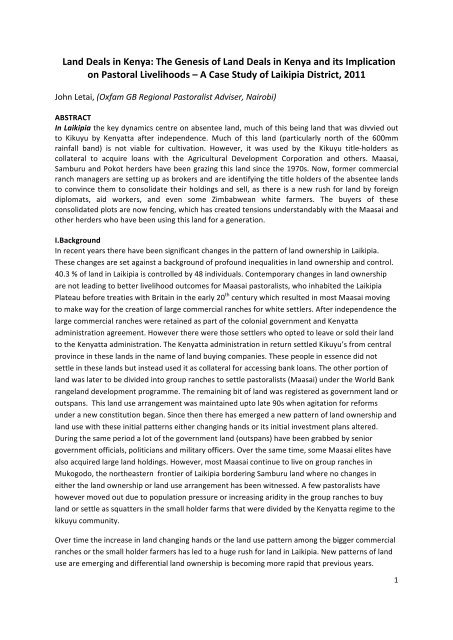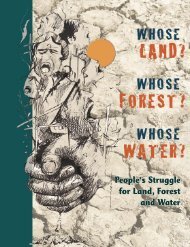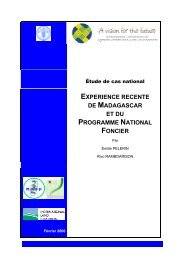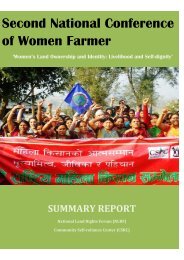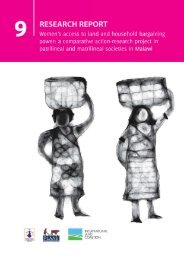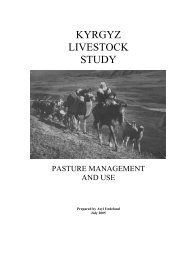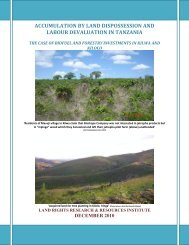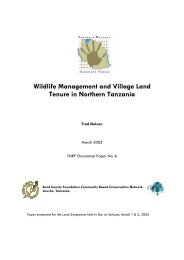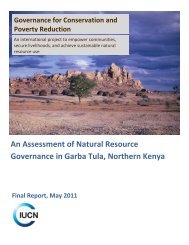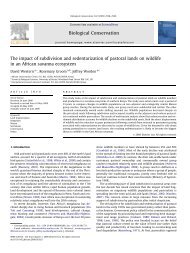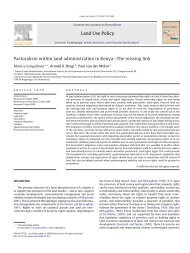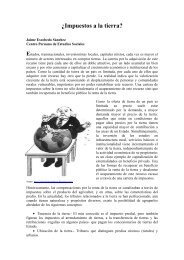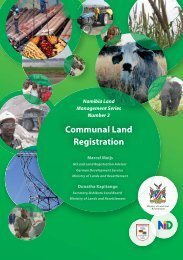Land Deals in Kenya: The Genesis of Land Deals in ... - Land Portal
Land Deals in Kenya: The Genesis of Land Deals in ... - Land Portal
Land Deals in Kenya: The Genesis of Land Deals in ... - Land Portal
Create successful ePaper yourself
Turn your PDF publications into a flip-book with our unique Google optimized e-Paper software.
<strong>Land</strong> <strong>Deals</strong> <strong>in</strong> <strong>Kenya</strong>: <strong>The</strong> <strong>Genesis</strong> <strong>of</strong> <strong>Land</strong> <strong>Deals</strong> <strong>in</strong> <strong>Kenya</strong> and its Implication<br />
on Pastoral Livelihoods – A Case Study <strong>of</strong> Laikipia District, 2011<br />
John Letai, (Oxfam GB Regional Pastoralist Adviser, Nairobi)<br />
ABSTRACT<br />
In Laikipia the key dynamics centre on absentee land, much <strong>of</strong> this be<strong>in</strong>g land that was divvied out<br />
to Kikuyu by <strong>Kenya</strong>tta after <strong>in</strong>dependence. Much <strong>of</strong> this land (particularly north <strong>of</strong> the 600mm<br />
ra<strong>in</strong>fall band) is not viable for cultivation. However, it was used by the Kikuyu title-‐holders as<br />
collateral to acquire loans with the Agricultural Development Corporation and others. Maasai,<br />
Samburu and Pokot herders have been graz<strong>in</strong>g this land s<strong>in</strong>ce the 1970s. Now, former commercial<br />
ranch managers are sett<strong>in</strong>g up as brokers and are identify<strong>in</strong>g the title holders <strong>of</strong> the absentee lands<br />
to conv<strong>in</strong>ce them to consolidate their hold<strong>in</strong>gs and sell, as there is a new rush for land by foreign<br />
diplomats, aid workers, and even some Zimbabwean white farmers. <strong>The</strong> buyers <strong>of</strong> these<br />
consolidated plots are now fenc<strong>in</strong>g, which has created tensions understandably with the Maasai and<br />
other herders who have been us<strong>in</strong>g this land for a generation.<br />
I.Background<br />
In recent years there have been significant changes <strong>in</strong> the pattern <strong>of</strong> land ownership <strong>in</strong> Laikipia.<br />
<strong>The</strong>se changes are set aga<strong>in</strong>st a background <strong>of</strong> pr<strong>of</strong>ound <strong>in</strong>equalities <strong>in</strong> land ownership and control.<br />
40.3 % <strong>of</strong> land <strong>in</strong> Laikipia is controlled by 48 <strong>in</strong>dividuals. Contemporary changes <strong>in</strong> land ownership<br />
are not lead<strong>in</strong>g to better livelihood outcomes for Maasai pastoralists, who <strong>in</strong>habited the Laikipia<br />
Plateau before treaties with Brita<strong>in</strong> <strong>in</strong> the early 20 th century which resulted <strong>in</strong> most Maasai mov<strong>in</strong>g<br />
to make way for the creation <strong>of</strong> large commercial ranches for white settlers. After <strong>in</strong>dependence the<br />
large commercial ranches were reta<strong>in</strong>ed as part <strong>of</strong> the colonial government and <strong>Kenya</strong>tta<br />
adm<strong>in</strong>istration agreement. However there were those settlers who opted to leave or sold their land<br />
to the <strong>Kenya</strong>tta adm<strong>in</strong>istration. <strong>The</strong> <strong>Kenya</strong>tta adm<strong>in</strong>istration <strong>in</strong> return settled Kikuyu’s from central<br />
prov<strong>in</strong>ce <strong>in</strong> these lands <strong>in</strong> the name <strong>of</strong> land buy<strong>in</strong>g companies. <strong>The</strong>se people <strong>in</strong> essence did not<br />
settle <strong>in</strong> these lands but <strong>in</strong>stead used it as collateral for access<strong>in</strong>g bank loans. <strong>The</strong> other portion <strong>of</strong><br />
land was later to be divided <strong>in</strong>to group ranches to settle pastoralists (Maasai) under the World Bank<br />
rangeland development programme. <strong>The</strong> rema<strong>in</strong><strong>in</strong>g bit <strong>of</strong> land was registered as government land or<br />
outspans. This land use arrangement was ma<strong>in</strong>ta<strong>in</strong>ed upto late 90s when agitation for reforms<br />
under a new constitution began. S<strong>in</strong>ce then there has emerged a new pattern <strong>of</strong> land ownership and<br />
land use with these <strong>in</strong>itial patterns either chang<strong>in</strong>g hands or its <strong>in</strong>itial <strong>in</strong>vestment plans altered.<br />
Dur<strong>in</strong>g the same period a lot <strong>of</strong> the government land (outspans) have been grabbed by senior<br />
government <strong>of</strong>ficials, politicians and military <strong>of</strong>ficers. Over the same time, some Maasai elites have<br />
also acquired large land hold<strong>in</strong>gs. However, most Maasai cont<strong>in</strong>ue to live on group ranches <strong>in</strong><br />
Mukogodo, the northeastern frontier <strong>of</strong> Laikipia border<strong>in</strong>g Samburu land where no changes <strong>in</strong><br />
either the land ownership or land use arrangement has been witnessed. A few pastoralists have<br />
however moved out due to population pressure or <strong>in</strong>creas<strong>in</strong>g aridity <strong>in</strong> the group ranches to buy<br />
land or settle as squatters <strong>in</strong> the small holder farms that were divided by the <strong>Kenya</strong>tta regime to the<br />
kikuyu community.<br />
Over time the <strong>in</strong>crease <strong>in</strong> land chang<strong>in</strong>g hands or the land use pattern among the bigger commercial<br />
ranches or the small holder farmers has led to a huge rush for land <strong>in</strong> Laikipia. New patterns <strong>of</strong> land<br />
use are emerg<strong>in</strong>g and differential land ownership is becom<strong>in</strong>g more rapid that previous years.<br />
1
This study exam<strong>in</strong>es the ma<strong>in</strong> types <strong>of</strong> land deals <strong>in</strong> Laikipia over the recent past. <strong>The</strong> aim is to<br />
understand the different category <strong>of</strong> land deals, who are the key domestic and <strong>in</strong>ternational actors<br />
<strong>in</strong>volved and <strong>in</strong> what ways are these land deals l<strong>in</strong>ked to other <strong>in</strong>vestments. It is important to<br />
understand <strong>in</strong> what ways are the outcomes <strong>of</strong> the chang<strong>in</strong>g land ownership impact<strong>in</strong>g on the<br />
livelihoods <strong>of</strong> the different groups and who stands to benefit from these changes and who losses.<br />
II. <strong>Land</strong> Tenure Regimes with<strong>in</strong> Laikipia District<br />
Below is a map <strong>of</strong> Laikipia district show<strong>in</strong>g the different land use options. <strong>The</strong>se land use options also<br />
def<strong>in</strong>e the tenure regimes that exist with<strong>in</strong> Laikipia<br />
<strong>The</strong> history <strong>of</strong> land <strong>in</strong> Laikipia district is unique and represents a multiplicity <strong>of</strong> diversity <strong>in</strong> the land<br />
use options compared to any other district <strong>in</strong> <strong>Kenya</strong>. Each tenure regime represents a unique type <strong>of</strong><br />
production system that is totally different from the other depend<strong>in</strong>g on the different categories.<br />
Though there are some that try to bridge some semblance with their neighbours most <strong>of</strong> the<br />
different regimes have different user arrangements and are guided by the land use system adopted<br />
by members <strong>of</strong> the same category. However the different land regimes are def<strong>in</strong>ed by the follow<strong>in</strong>g<br />
tenure arrangements<br />
1. Large scale ranches<br />
<strong>The</strong>re are 48 large scale ranches represent<strong>in</strong>g 40.3% <strong>of</strong> the total land area <strong>in</strong> laikipia. <strong>The</strong>y occupy<br />
huge tracts <strong>of</strong> land with Laikipia ranch<strong>in</strong>g hav<strong>in</strong>g 92,555.21 acres followed by Olpajeta, then<br />
Colcheccio currently Loisaba 62,092.97 and Oljogi 54,048.65 be<strong>in</strong>g the biggest <strong>of</strong> the 48 ranches. <strong>The</strong><br />
smallest <strong>of</strong> all is Andrecaple with 416.45 acres. Most <strong>of</strong> these ranches were acquired dur<strong>in</strong>g the<br />
colonial time and legislation govern<strong>in</strong>g their ownership borrowed from the colonial law <strong>in</strong>to the<br />
2
<strong>in</strong>dependent <strong>Kenya</strong>n constitution under the land transfer agreement between the colonial<br />
government and the <strong>Kenya</strong>tta regime. It is important to po<strong>in</strong>t out here that dur<strong>in</strong>g the maasai land<br />
campaign <strong>of</strong> 2004 agitat<strong>in</strong>g for the government to address historical <strong>in</strong>justices on land based on the<br />
Aglo-‐Maasai British agreements <strong>of</strong> 1904-‐11, it was realised that some <strong>of</strong> these ranches have no legal<br />
documents.<br />
2. Large scale farms<br />
Large scale farms are 23 and represent 1.48% <strong>of</strong> Laikipia distirct. <strong>The</strong>se are farms held by <strong>in</strong>dividuals<br />
mostly from central prov<strong>in</strong>ce who got them dur<strong>in</strong>g the time <strong>Kenya</strong>tta was subdivid<strong>in</strong>g the land after<br />
<strong>in</strong>dependence or by land buy<strong>in</strong>g companies that opted not to sub-‐divide them but use the land<br />
collectively as collateral for access<strong>in</strong>g bank loans. Such farms belong<strong>in</strong>g to land buy<strong>in</strong>g companies<br />
<strong>in</strong>clude Suguroi(4,526.50 acres) and Murera(1385.81 acres). Farms held by Individuals <strong>in</strong>clude<br />
Rware-‐3(1089.10) held by President Kibaki’s family, Mathenge(1817.64) held by a former prov<strong>in</strong>cial<br />
commissioner <strong>in</strong> the <strong>Kenya</strong>tta and Moi regimes and Mohammed(1091.59) held by a former chief <strong>of</strong><br />
general staff <strong>of</strong> the arms forces <strong>of</strong> <strong>Kenya</strong>. Some <strong>of</strong> these farms are also still <strong>in</strong> the hands <strong>of</strong><br />
descendants’ <strong>of</strong> colonial ancestry such as Jenn<strong>in</strong>g (2123.02), George (1969.87) and John C. Cardoville<br />
(1077.02).<br />
3. Group ranches<br />
<strong>The</strong>re are 13 group ranches <strong>in</strong> laikipia districts represent<strong>in</strong>g 7.45% <strong>of</strong> the total land area. All <strong>of</strong> them<br />
are found <strong>in</strong> the northern dry part <strong>of</strong> the district and are occupied by pastoralists who use them for<br />
communal graz<strong>in</strong>g. However some <strong>of</strong> the group ranches such as Il-‐ngwesi, Kijabe, Lekuruki and Koija<br />
have wildlife conservancies and tourist lodges. In terms <strong>of</strong> tenure arrangement all group ranches<br />
have not been sub-‐divided and rema<strong>in</strong> <strong>in</strong>tact though faced by grow<strong>in</strong>g population pressure that is<br />
putt<strong>in</strong>g a stra<strong>in</strong> on natural resources<br />
4. Small holder farms<br />
Small holder farms represent a total <strong>of</strong> 27.21% <strong>of</strong> the total land area <strong>in</strong> Laikipia and are 122 <strong>in</strong><br />
number. <strong>The</strong>se farms were <strong>in</strong>itially large scale farms bought by groups <strong>of</strong> <strong>in</strong>dividuals who later sub-‐<br />
divide them <strong>in</strong>to small hold<strong>in</strong>g <strong>of</strong> between 2 – 5 acres. <strong>The</strong>se farms represent three categories <strong>of</strong><br />
farmers. Those who bought and settled as a result <strong>of</strong> land pressure from their ancestral land or<br />
those who bought for speculative purposes <strong>in</strong> the hope that prices will rise so that they could sell<br />
them later. A third group are those who bought and used them as collateral for access<strong>in</strong>g bank<br />
loans. <strong>The</strong> first group majority <strong>of</strong> them still live <strong>in</strong> these farms do<strong>in</strong>g subsistence ra<strong>in</strong> fed agriculture.<br />
Most members <strong>of</strong> the two other groups represent the case <strong>of</strong> absentee landlords. <strong>The</strong>se lands<br />
rema<strong>in</strong> idle and unoccupied. However overtime while search<strong>in</strong>g for pasture or water for their<br />
animals or due to population pressure <strong>in</strong> the group ranches pastoralists have moved to settle <strong>in</strong><br />
these farms either as squatters or a few <strong>of</strong> them have bought them and have title deeds.<br />
5. Government land<br />
<strong>The</strong>se are 36 pieces <strong>of</strong> land owned by the government represent<strong>in</strong>g 6.58% <strong>of</strong> the land area <strong>in</strong> the<br />
district. <strong>The</strong>se lands are used for tra<strong>in</strong><strong>in</strong>g by the military and national youth service. <strong>The</strong>y are also<br />
used as livestock hold<strong>in</strong>g grounds by the m<strong>in</strong>istry <strong>of</strong> livestock and veter<strong>in</strong>ary services dur<strong>in</strong>g<br />
quarant<strong>in</strong>es or by the agricultural development corporation. Research <strong>in</strong>stitutions also used them<br />
for research purposes<br />
6. Forest reserves<br />
<strong>The</strong>re are two categories <strong>of</strong> forest reserves. Disturbed forest reserves which are 4 represent<strong>in</strong>g<br />
2.78% and <strong>in</strong>tact forest reserves which are 8 represent<strong>in</strong>g 4.75% <strong>of</strong> the total land area. <strong>The</strong><br />
disturbed forests are where government have allowed cultivation <strong>in</strong>side with an agreement with the<br />
3
farmers that they will plant trees and <strong>in</strong>tegrate crops <strong>in</strong> them. Disturbed forests are also those found<br />
neighbour<strong>in</strong>g farm<strong>in</strong>g communities and have exploited them for firewood or timber production.<br />
Intact forests are those where pastoralists graze their animals or those where conservation is tak<strong>in</strong>g<br />
place thus limited human activity is allowed or are under community or private management<br />
system.<br />
Table giv<strong>in</strong>g a summary <strong>of</strong> the different tenure regimes exist<strong>in</strong>g <strong>in</strong> Laikipia District<br />
Type <strong>of</strong> Tenure Regime Total land area <strong>in</strong> Acres Total <strong>in</strong> number Percentage land<br />
occupied <strong>in</strong> the district<br />
Large scale ranches 937,582.65 48 40.3%<br />
Large scale farms 34,471.00 23 1.48%<br />
Group ranches 173,441.26 13 7.45%<br />
Small holder farms 633,069.79 122 27.21%<br />
Disturbed forest reserves 64,739.45 4 2.78%<br />
Intact forest reserves 110,693.02 8 4.75%<br />
Government land (outspans) 153,121.18 36 6.58%<br />
Others ? ? 9.45%<br />
II. A. Research observation <strong>of</strong> the different tenure regimes<br />
Some <strong>of</strong> the key observations com<strong>in</strong>g out <strong>of</strong> the research process have given an <strong>in</strong>dication on how<br />
land might be chang<strong>in</strong>g hands <strong>in</strong> Laikipia either with or without the knowledge <strong>of</strong> the m<strong>in</strong>istry <strong>of</strong><br />
lands. <strong>The</strong> large scale ranches from an outside perspective are consolidated and fenced as one unit<br />
each. However look<strong>in</strong>g at the data from the M<strong>in</strong>istry <strong>of</strong> local government where these ranches pay<br />
land rates most <strong>of</strong> the farms are <strong>in</strong>ternally sub-‐divided <strong>in</strong>to small units <strong>of</strong> vary<strong>in</strong>g acreage with each<br />
unit hav<strong>in</strong>g a different land rate number. Out <strong>of</strong> the 48 large scale ranches 16 are <strong>in</strong>ternally<br />
subdivided with each unit hav<strong>in</strong>g to pay land rate <strong>of</strong> vary<strong>in</strong>g amounts depend<strong>in</strong>g on their sizes.<br />
Oljogi farm has 10 pieces which is the highest number <strong>of</strong> small units followed by Olpajeta with 9 and<br />
Mpala farm with 7. Accord<strong>in</strong>g to discussions with the local government <strong>of</strong>ficials (though there were<br />
no records to validate the discussion) the reason for such parcell<strong>in</strong>g <strong>of</strong> land were advanced from two<br />
fronts. One is that each <strong>of</strong> the parcels were owned by an <strong>in</strong>dependent <strong>in</strong>dividual who pays the land<br />
rate depend<strong>in</strong>g on the size <strong>of</strong> the parcel. <strong>The</strong> other argument is that this parcell<strong>in</strong>g denies the local<br />
authority the consolidate land rate which is higher as opposed to when the land is divided <strong>in</strong>to<br />
parcels. However one <strong>of</strong> the big challenges fac<strong>in</strong>g such an arrangement is lack <strong>of</strong> <strong>in</strong>formation from<br />
the M<strong>in</strong>istry <strong>of</strong> lands to back up the arguments. Discussions po<strong>in</strong>ted out to the fact that many <strong>of</strong> the<br />
transactions are done at an <strong>in</strong>dividual level without necessarily <strong>in</strong>volv<strong>in</strong>g the M<strong>in</strong>istry <strong>of</strong> lands. <strong>The</strong>re<br />
were claims that some <strong>of</strong> the parcels with<strong>in</strong> the bigger ranches have been sold to people <strong>of</strong><br />
4
European orig<strong>in</strong> some com<strong>in</strong>g from Zimbabwe while others are retir<strong>in</strong>g people from Europe who<br />
wanted to settle <strong>in</strong> <strong>Kenya</strong> thus f<strong>in</strong>d<strong>in</strong>g their way to Laikipia through their social network. <strong>The</strong> only<br />
evidence that could back up such claim is the rapid emergence <strong>of</strong> palatial private residence <strong>in</strong> some<br />
<strong>of</strong> the parcels with<strong>in</strong> these ranches. This po<strong>in</strong>ts out to the fact that there is an <strong>in</strong>crease <strong>in</strong> the<br />
population <strong>of</strong> the white settler community with<strong>in</strong> the big ranches. <strong>The</strong> other school <strong>of</strong> thoughts<br />
<strong>in</strong>dicates that the private residences are actually tourist dest<strong>in</strong>ations <strong>of</strong> high class nature but built<br />
without government knowledge. Tourist pay for their fees <strong>in</strong> Europe and just come to occupy the<br />
premises as residence thus the owners avoid taxation. Aga<strong>in</strong> this cannot be fully verified as Laikipia<br />
Wildlife Forum as <strong>in</strong>dicated later <strong>in</strong> this research has given a majority <strong>of</strong> the tourist dest<strong>in</strong>ations <strong>in</strong><br />
Laikipia <strong>in</strong> its website thus one may not classify the private residences as tourist dest<strong>in</strong>ations.<br />
<strong>The</strong> large scale farms on the other hand are rapidly be<strong>in</strong>g acquired by big mult<strong>in</strong>ationals for<br />
horticulture purposes. Those particularly near permanent water sources have been taken over by<br />
the mult<strong>in</strong>ation companies which immediately turn them <strong>in</strong>to horticulture farms where they grow<br />
crops that are exported to the European market. Among these farms <strong>in</strong>clude Naromoru Farm,<br />
Murungai and Murera<br />
Look<strong>in</strong>g at the small holder farms all <strong>of</strong> them were <strong>in</strong>itially parcelled <strong>in</strong>to small hold<strong>in</strong>gs and<br />
occupied by farmers settled by former president <strong>Kenya</strong>tta or used as collateral to access bank loans<br />
thus rema<strong>in</strong><strong>in</strong>g as absentee lands where pastoralists have settled over time as squatters. However<br />
over recent years there has emerged a group <strong>of</strong> former ranch managers <strong>of</strong> the large scale ranches<br />
who are act<strong>in</strong>g as brokers between the owners <strong>of</strong> these farms and will<strong>in</strong>g buyers mostly <strong>of</strong> European<br />
orig<strong>in</strong>. <strong>The</strong>y collude with the M<strong>in</strong>istry <strong>of</strong> lands <strong>of</strong>ficials to consolidate these small parcels <strong>in</strong>to large<br />
hold<strong>in</strong>gs and sell them to white people. One <strong>of</strong> the research f<strong>in</strong>d<strong>in</strong>gs <strong>in</strong>dicate that the buyers might<br />
not be aware <strong>of</strong> the complexity <strong>of</strong> such deal<strong>in</strong>gs as they buy the land only to come later to realise<br />
that there are people liv<strong>in</strong>g there thus f<strong>in</strong>d<strong>in</strong>g it difficult to move or evict them. Case examples<br />
where such practices are be<strong>in</strong>g undertaken <strong>in</strong>clude Ethi (4742.18), East Laikipia (12152.06) and<br />
Kimugandura (10139.14). This scenario is a potential source <strong>of</strong> conflict. In 2008 pastoralists <strong>in</strong>vaded<br />
part <strong>of</strong> the kimugandura ranch that was fenced and brought down the fence protest<strong>in</strong>g at the<br />
acquisition and fenc<strong>in</strong>g <strong>of</strong> an important water source. <strong>The</strong>y later went to court claim<strong>in</strong>g ownership<br />
<strong>of</strong> the land as some <strong>of</strong> them have lived there s<strong>in</strong>ce 1980 more than 12 years that the <strong>Kenya</strong>n law<br />
gives one to stay <strong>in</strong> a place then claim the right <strong>of</strong> ownership. <strong>The</strong> case is still pend<strong>in</strong>g <strong>in</strong> court.<br />
Group ranches have not been affected by the process <strong>of</strong> land chang<strong>in</strong>g hands. All <strong>of</strong> them are <strong>in</strong>tact<br />
and occupied by pastoralists who do graz<strong>in</strong>g communally us<strong>in</strong>g traditional graz<strong>in</strong>g management.<br />
However a majority <strong>of</strong> the group ranches have limited ground cover due to <strong>in</strong>tensive graz<strong>in</strong>g and the<br />
<strong>in</strong>creas<strong>in</strong>g frequency <strong>of</strong> drought/limited ra<strong>in</strong>fall that does not allow them to regenerate to full<br />
potential.<br />
Government land was among the earliest lands to be grabbed <strong>in</strong> Laikipia. Only 5 out <strong>of</strong> the 36<br />
government outspans have not been grabbed and are managed by government parastatals such as<br />
the Agricultural F<strong>in</strong>ance Corporation(ADC) or the military like the National Youth Service(NYS). <strong>The</strong>se<br />
<strong>in</strong>clude ADC Mutara(60,874.54), Makurian Hold<strong>in</strong>g Ground(854.64), Kimanjo Hold<strong>in</strong>g<br />
Ground(1027.42) Kirimon NYS(39884.78) and NYS Mar mar(43880.45). <strong>The</strong>se lands have been<br />
grabbed by senior government <strong>of</strong>ficials, politicians and the military personnels. Others have been<br />
5
grabbed by managers <strong>of</strong> large scale ranches <strong>in</strong> places where the outspans neighbour large scale<br />
ranches. Most <strong>of</strong> these lands have also changed hands s<strong>in</strong>ce they were acquired by <strong>in</strong>dividuals.<br />
<strong>The</strong> f<strong>in</strong>al category <strong>of</strong> land <strong>in</strong> Laikipia are forest reserves. This can be categorised <strong>in</strong>to two. Disturbed<br />
and <strong>in</strong>tact forest reserves. Disturbed forests are those that have lost their vegetative cover mostly<br />
due to human activity or settlement. <strong>The</strong>se <strong>in</strong>clude Marmanet forest where the Moi regime<br />
allocated land to people who supported the establishment at the time and Ewaso Narok, Rumuruti<br />
and Lariak forests that have been depleted due to human activities. When the Kibaki adm<strong>in</strong>istration<br />
took over <strong>in</strong> 2002 there has been constant threats <strong>of</strong> eviction to people liv<strong>in</strong>g <strong>in</strong> the Marmanet<br />
forest as a result <strong>of</strong> exploitation <strong>of</strong> the forest and reduced water levels <strong>in</strong> the rivers whose sources<br />
are from this forest.<br />
Intact forests are those where human activities are go<strong>in</strong>g on but have not impacted negatively on<br />
the forest. Most <strong>of</strong> these forests are used for herd<strong>in</strong>g where livestock are driven <strong>in</strong>to the forest<br />
dur<strong>in</strong>g the day and out <strong>in</strong> the even<strong>in</strong>g except Mukogodo forest where pastoralists live <strong>in</strong>side. Many<br />
<strong>of</strong> the <strong>in</strong>tact forests are either occupied by pastoralists or conservation group such as Lewa wildlife<br />
conservancy. <strong>The</strong> management <strong>of</strong> the forest is also under communities or conservation groups<br />
jo<strong>in</strong>tly with communities with the <strong>Kenya</strong> forest service play<strong>in</strong>g an oversight role.<br />
III. <strong>The</strong> Emerg<strong>in</strong>g <strong>Land</strong> <strong>Deals</strong> – Case Examples<br />
As already <strong>in</strong>dicated earlier <strong>in</strong> this report, land deals have been on the rise <strong>in</strong> Laikipia s<strong>in</strong>ce 1990. <strong>The</strong><br />
deals <strong>in</strong>volve various stakeholders <strong>in</strong>clud<strong>in</strong>g big commercial ranchers (most <strong>of</strong> them a generation <strong>of</strong><br />
the colonial ancestry), politician with the three <strong>in</strong>dependent <strong>Kenya</strong> presidents own<strong>in</strong>g land <strong>in</strong><br />
Laikipia, senior government <strong>of</strong>ficial, military <strong>of</strong>ficers and pastoralists elites who are part <strong>of</strong> the<br />
government and have played a role <strong>in</strong> appropriat<strong>in</strong>g land for themselves at the expense <strong>of</strong> their<br />
communities<br />
An observation by the research team <strong>in</strong>dicates that some <strong>of</strong> these deals are be<strong>in</strong>g done <strong>in</strong> a secret<br />
maners as no documentation is available at the lands <strong>of</strong>fices yet other data such as from the local<br />
government <strong>of</strong>fices shows parcel<strong>in</strong>g <strong>of</strong> land <strong>in</strong>to smaller units. However look<strong>in</strong>g from the outside the<br />
ranches are fenced as one unit. Most <strong>of</strong> the big ranches have representation at the district land<br />
board but only attend the board meet<strong>in</strong>gs when they have a particular agenda they want to<br />
<strong>in</strong>fluence. Its argued that most <strong>of</strong> the deals are done through private arrangements by sign<strong>in</strong>g<br />
Memorandum <strong>of</strong> Understand<strong>in</strong>g between the different parties without hav<strong>in</strong>g to go through the<br />
legal and procedural processes as some <strong>of</strong> the deals <strong>in</strong>volve people com<strong>in</strong>g from Zimbabwe runn<strong>in</strong>g<br />
away from the land and governance turmoil <strong>in</strong> the country. <strong>The</strong> other group are retir<strong>in</strong>g people from<br />
western countries who are settl<strong>in</strong>g <strong>in</strong> <strong>Kenya</strong> or want to develop holiday residences while a third<br />
group is driven by an <strong>in</strong>vestment agenda mostly tourism.<br />
Large scale farm deals ma<strong>in</strong>ly <strong>in</strong>volve large mult<strong>in</strong>ational companies do<strong>in</strong>g horticulture, wheat<br />
farm<strong>in</strong>g and high quality beef cattle ranch<strong>in</strong>g. Among the mult<strong>in</strong>ational companies <strong>in</strong>clude<br />
homegrown, Batian, Vita cress and AAAK which ma<strong>in</strong>ly grow products for the European market.<br />
Recently there has also emerged a group <strong>of</strong> former ranch managers who are act<strong>in</strong>g as brokers<br />
work<strong>in</strong>g closely with land <strong>of</strong>ficials to consolidate small holder farms <strong>of</strong> absentee landlords then later<br />
they look for the owners and l<strong>in</strong>k them to <strong>in</strong>dividuals or companies that buy the land as consolidated<br />
6
units. However this has s<strong>in</strong>ce proved controversial as most <strong>of</strong> these lands are occupied by<br />
pastoralists liv<strong>in</strong>g as squatters. Pastoralists <strong>in</strong> some <strong>in</strong>stances have challenged this move and the<br />
new owners <strong>of</strong> the land have found themselves unable to occupy the land. Cases <strong>of</strong> such deals<br />
<strong>in</strong>clude Ethi farm, East Laikipia farmers and Kimugandura where pastoralists have refused to move<br />
and <strong>in</strong>stead went to court to challenge the legality <strong>of</strong> the move.<br />
<strong>The</strong> table below gives examples <strong>of</strong> land that has changed hands recently with Laikipia<br />
Ranch Acreage Comments<br />
Kimokandora<br />
Ranch<br />
Large scale ranches<br />
7,142.86 Formerly owned by Mugambi and sold to white Zimbabweans who<br />
visit it over weekends<br />
Loisaba Ranch 62,092.97 Formerly owned by an Italian now by an American but leased to<br />
Wilderness Guardian Company<br />
Mugie Limited 43,985.95 Formerly owned by <strong>Kenya</strong>’s first African chief justice (Kitili<br />
Mwendwa) but have changed hands 3 times s<strong>in</strong>ce 1980 with the<br />
current owners be<strong>in</strong>g the <strong>Kenya</strong>tta family<br />
Ol Jogi Limited 54,048.65 Changed hands twice s<strong>in</strong>ce 1980 and divided <strong>in</strong>to 10 pieces currently<br />
owned by a French American who bought from an Italian<br />
Ole Naisho 29,005.08 Formely Kamwaki 1963 owned by a Dane, sold to the Delamere<br />
family; divided to 2 pieces<br />
Ol Pejeta<br />
Ranch<strong>in</strong>g CO<br />
Samburu<br />
Limited<br />
88,923.79 Changed hands six times s<strong>in</strong>ce 1963. Owners <strong>in</strong>cluded Lord<br />
Delamere, Onassis, later Adnan Kashoggi, T<strong>in</strong>y Rowland’s Lonrho,<br />
Daniel Arap Moi then currently BCP. Divided to 9 pieces<br />
24,000 Formely <strong>of</strong> Munene Kairo (Mwai Kibaki’s trusted aide) and now<br />
Offbeat Safaris<br />
Segera Ranch 21,442 Formerly owned by Philip Valent<strong>in</strong>e and now owner is an American<br />
<strong>in</strong>vestor (Puma Company). Divided <strong>in</strong>to 4 pieces<br />
IV. <strong>Land</strong> deals and their l<strong>in</strong>k to <strong>in</strong>vestment<br />
Several arguments have been advanced regard<strong>in</strong>g the rationale beh<strong>in</strong>d the rapid land deals<br />
emerg<strong>in</strong>g <strong>in</strong> Laikipia. Some suggest that this is as a response to the land reform agenda which was<br />
part <strong>of</strong> the clamour for the new constitution. Others have po<strong>in</strong>ted out the quest by some<br />
communities to address historical <strong>in</strong>justices based on the skewed land arrangement <strong>in</strong> Laikipia<br />
where some have more than enough while communities are struggl<strong>in</strong>g to make ends meet out <strong>of</strong><br />
small parcels. However despite these arguments one clear th<strong>in</strong>g is that <strong>in</strong>vestment emerges as one<br />
7
<strong>of</strong> the pr<strong>in</strong>ciple reasons why land is chang<strong>in</strong>g hands at such a rapid rate. A major <strong>in</strong>vestment is <strong>in</strong> the<br />
tourism and<br />
wildlife<br />
conservation Laikipia is widely accredited as <strong>Kenya</strong>’s premier safari dest<strong>in</strong>ation<br />
sector. This is with ideals and practices that are at the forefront <strong>of</strong> conservation<br />
exemplified by tourism. <strong>The</strong> comb<strong>in</strong>ation <strong>of</strong> abundant wildlife and exceptional<br />
some <strong>of</strong> the scenic beauty provides the basis for Laikipia’s unique and high<br />
statements<br />
quality tourism. Here, wildlife is free to roam between ranches,<br />
from various<br />
conservancies and community lands <strong>in</strong>to <strong>Kenya</strong>’s northern<br />
websites<br />
rangelands<br />
market<strong>in</strong>g the<br />
tourism <strong>in</strong>dustry Quotation courtesy <strong>of</strong> Laikipia Wildlife Forum publication<br />
In Laikipia like<br />
this one from Laikipia wildlife forum.<br />
Laikipia has the highest number <strong>of</strong> wildlife <strong>in</strong> <strong>Kenya</strong> outside protected areas. Most <strong>of</strong> the ranches<br />
have been turned<br />
overtime <strong>in</strong>to wildlife<br />
Laikipia has some <strong>of</strong> Africa’s most luxurious safari lodges and<br />
camps, and the district also hosts the highest number <strong>of</strong><br />
community-‐owned lodges <strong>in</strong> <strong>Kenya</strong><br />
Laikipia <strong>of</strong>fers the freedom and space for visitors to walk,<br />
ride, cycle and camp amongst a great diversity <strong>of</strong> wildlife and<br />
wild landscapes, aga<strong>in</strong>st the dramatic backdrop <strong>of</strong> Mount<br />
<strong>Kenya</strong>. A sense <strong>of</strong> belong<strong>in</strong>g through engagement with<br />
Maasai guides, hosts and local people, is someth<strong>in</strong>g that<br />
visitors take home with them<br />
Quotation courtesy <strong>of</strong> Laikipia Wildlife Forum publication<br />
sanctuaries. Group<br />
ranches have also been<br />
converted <strong>in</strong>to<br />
community wildlife<br />
conservation trusts.<br />
Laikipia equally has the<br />
highest number <strong>of</strong><br />
tourist facilities<br />
compared to any other<br />
county <strong>in</strong> the <strong>in</strong>terior <strong>of</strong><br />
the country. Some <strong>of</strong> the<br />
lodges are classified as<br />
world class most<br />
luxurious. <strong>The</strong> table below shows the different types <strong>of</strong> tourist facilities and their number <strong>in</strong> Laikipia<br />
District<br />
Type <strong>of</strong> Tourist Facility Number<br />
Day Visits Conservancies 5<br />
Lodges 14<br />
Ranch Houses 10<br />
Tented Camps 11<br />
Hotels 3<br />
8
Camp<strong>in</strong>g Sites 1<br />
Wild Camp<strong>in</strong>g 8<br />
Adventure Safaris 10<br />
Air Charter (Nanyuki Airstrip) 1<br />
Book<strong>in</strong>g Safaris 6<br />
Other <strong>in</strong>vestments <strong>in</strong>clude horticulture farm<strong>in</strong>g be<strong>in</strong>g practiced <strong>in</strong> large scale farms, wheat farm<strong>in</strong>g<br />
cattle ranch<strong>in</strong>g and the dairy <strong>in</strong>dustry. Some <strong>of</strong> the big ranches and large scale farms have also<br />
developed research foundations or conservation trust where they receive fund<strong>in</strong>g from <strong>in</strong>dividuals<br />
or <strong>in</strong>stitutions with an <strong>in</strong>terest <strong>in</strong> conserv<strong>in</strong>g wildlife species particularly endangered species like the<br />
African black rh<strong>in</strong>o, wild-‐dogs, gravy zebra and other species. <strong>The</strong>se farms <strong>in</strong>clude Lewa wildlife<br />
conservancy, Olpajeta, Chololo ranch under the Leakey Foundation (1999), Mpala research centre as<br />
well as Mpala Wildlife foundation. Others are partner<strong>in</strong>g with neighbour<strong>in</strong>g group ranches to <strong>in</strong>itiate<br />
jo<strong>in</strong>t conservation projects and <strong>in</strong>vest<strong>in</strong>g <strong>in</strong> community lodges. <strong>The</strong>y establish community<br />
conservation groups and go out sourc<strong>in</strong>g for donor fund<strong>in</strong>g to implement the projects. Other<br />
projects implemented besides conservation <strong>in</strong>clude community based healthcare outreach<br />
programmes, curio shops trade and tree nurseries.<br />
<strong>The</strong> consolidated small scale farms are <strong>in</strong>vest<strong>in</strong>g on develop<strong>in</strong>g private residences for people from<br />
western countries who come dur<strong>in</strong>g their holidays and do not have to put up <strong>in</strong> hotels or lodges.<br />
Others are develop<strong>in</strong>g horticulture, wildlife conservation and pasture bulk<strong>in</strong>g for sale to ranches<br />
with livestock dur<strong>in</strong>g the dry season<br />
A new emergence <strong>in</strong> land <strong>in</strong>vestment which is develop<strong>in</strong>g among large scale ranches is the use <strong>of</strong><br />
those ranches for British Army tra<strong>in</strong><strong>in</strong>g/drill exercises. Initially only Lewa and Mpala farms were used<br />
for military exercises but <strong>of</strong> late other farms like Oljogi, Oldaiga, Ole Naisho and Olpajeta have come<br />
to <strong>in</strong>clude military tra<strong>in</strong><strong>in</strong>g/drill exercises <strong>in</strong> their farms. However there is no data on this new form<br />
<strong>of</strong> land use <strong>in</strong>terms <strong>of</strong> return to <strong>in</strong>vestment or how much they pay for us<strong>in</strong>g such lands.<br />
V. Impact <strong>of</strong> land deals on other livelihood groups -‐ <strong>in</strong>itial observation<br />
<strong>Land</strong> deals are com<strong>in</strong>g to compound an already exist<strong>in</strong>g multiplicity <strong>of</strong> problems related to access<br />
use and management <strong>of</strong> scarce resources <strong>in</strong> Laikipia district. Laikipia compared to neighbour<strong>in</strong>g<br />
districts is a buffer zone that receives moderate ra<strong>in</strong>fall and does not suffer severe droughts except<br />
<strong>in</strong> those exceptional cases like 2009. Over time many pastoralists have moved from Bar<strong>in</strong>go,<br />
Samburu and Isiolo districts to settle <strong>in</strong> Laikipia <strong>in</strong> search <strong>of</strong> water and pasture for their livestock. On<br />
the other hand land pressure <strong>in</strong> central prov<strong>in</strong>ce is forc<strong>in</strong>g subsistent farmers to move and settle <strong>in</strong><br />
Laikipia do<strong>in</strong>g marg<strong>in</strong>al ra<strong>in</strong> fed agriculture sometimes <strong>in</strong>tegrat<strong>in</strong>g it with small herds <strong>of</strong> sheep, goats<br />
and cattle. This has led to competition for space and resources coupled with <strong>in</strong>creas<strong>in</strong>g frequency <strong>of</strong><br />
drought and aridity as witnessed <strong>in</strong> recent years.<br />
9
With the emergence <strong>of</strong> the rapid <strong>in</strong>crease <strong>in</strong> land deals more competition is be<strong>in</strong>g witnessed <strong>in</strong><br />
resource shar<strong>in</strong>g and access. <strong>The</strong>re is an <strong>in</strong>crease <strong>in</strong> land pressure due to limited access lead<strong>in</strong>g to<br />
<strong>in</strong>crease <strong>in</strong> levels <strong>of</strong> vulnerability among farmers &pastoralists. <strong>The</strong> small holder land consolidation<br />
process be<strong>in</strong>g undertaken by former land managers who are brok<strong>in</strong>g for <strong>in</strong>dividual buyers is reduc<strong>in</strong>g<br />
the total land available for pastoralists and farmers as they have to move <strong>in</strong> certa<strong>in</strong> <strong>in</strong>stances to look<br />
for alternative space. This has meant that with slight changes <strong>in</strong> the weather pattern these groups<br />
suffer heavy losses <strong>of</strong> livestock and crop failure as they have limited options to adjust to lead<strong>in</strong>g to a<br />
general <strong>in</strong>crease <strong>in</strong> vulnerability among these groups.<br />
<strong>Land</strong> deals have also led to an <strong>in</strong>crease <strong>in</strong> land use conflicts. Most <strong>of</strong> the land targeted for sale are<br />
small holder farms or large scale farms where there has been absentee landlords. Pastoralists or<br />
farmer have overtime occupied these lands and have to be moved or given notices <strong>of</strong> evictions<br />
whenever the land deals are entered <strong>in</strong>to between the owners and buyers. This has led to conflicts<br />
as the squatter groups have <strong>of</strong>ten defied these directives. In certa<strong>in</strong> cases the squatters have moved<br />
to court seek<strong>in</strong>g legal redress as they have lived <strong>in</strong> these farms for more than twelve(12) years and<br />
the law gives lee way for one to lay claim <strong>of</strong> ownership <strong>of</strong> the land if they have lived <strong>in</strong> that piece <strong>of</strong><br />
land over that period. <strong>The</strong>re are also <strong>in</strong>stances where pastoralists have pulled down fences erected<br />
on those farms and issued threats to the new occupants lead<strong>in</strong>g to more conflicts. Examples <strong>of</strong> such<br />
land where pastoralists have sort legal redress <strong>in</strong>clude Eland Down owned by former president Moi<br />
and sold to a group <strong>of</strong> American conservationists who sub-‐contracted it’s management to African<br />
Wildlife Foundation and Kimugandura farm owned by a group <strong>of</strong> seven rich Kikuyus from central<br />
prov<strong>in</strong>ce who used the farm as collateral to access loans from the Agricultural F<strong>in</strong>ance Corporation.<br />
This scenario is also related to the whole issue <strong>of</strong> consolidation <strong>of</strong> land that benefits a small group <strong>of</strong><br />
<strong>in</strong>dividuals versus loss <strong>of</strong> land by a greater majority<br />
<strong>The</strong> land deals have contributed to the <strong>in</strong>ability to cope among pastoralists and farmers <strong>in</strong>case <strong>of</strong><br />
normal ra<strong>in</strong>fall failure. <strong>The</strong> reduction <strong>in</strong> the total amount <strong>of</strong> available land has led to reduced<br />
mobility. This <strong>in</strong> turn has led to loss <strong>of</strong> assets (livestock) thus any slight changes <strong>in</strong> the weather<br />
pattern means that pastoralists have to rely on relief food from government <strong>in</strong> order to survive the<br />
harsh conditions<br />
This practice is equally blamed for over exploitation <strong>of</strong> natural resources <strong>in</strong> some areas and<br />
conservation <strong>in</strong> others. In areas particularly occupied by the agricultural community most <strong>of</strong> the<br />
natural resources (forest cover) have been exploited either for charcoal burn<strong>in</strong>g, firewood and<br />
timber production as people try different options to meet their household daily <strong>in</strong>comes. From the<br />
pastoralists areas susta<strong>in</strong>ed graz<strong>in</strong>g <strong>of</strong> the range lands due to constra<strong>in</strong>ed mobility has led to limited<br />
or lack <strong>of</strong> space for the range to regenerate. This <strong>in</strong>turn has led to degradation <strong>of</strong> the land and<br />
emerg<strong>in</strong>g <strong>of</strong> unpalatable <strong>in</strong>vasive species <strong>of</strong> plants like prosopis that render graz<strong>in</strong>g areas unusable<br />
help<strong>in</strong>g compound the whole issue <strong>of</strong> pasture access <strong>in</strong> few areas left for pastoralists to graze.<br />
In areas where jo<strong>in</strong>t management <strong>of</strong> lands have been <strong>in</strong>itiated such as the forest reserves<br />
conservation <strong>of</strong> resource is prioritised and the different user groups have developed natural<br />
resource use management plans. Also <strong>in</strong> the large scale ranches, large farms, consolidated small<br />
holder farms and some group ranches where resource use and management falls under few<br />
<strong>in</strong>dividuals conservation and use <strong>of</strong> resources is practised under <strong>in</strong>tensive management. This has<br />
10
ensured availability <strong>of</strong> resources even dur<strong>in</strong>g times <strong>of</strong> stress. <strong>The</strong> negative aspect <strong>of</strong> availability and<br />
non availability <strong>of</strong> resources <strong>in</strong> one group <strong>of</strong> users versus the other is that it leads to conflict as those<br />
who do have will always tend to poach from those who have. A case example is where pastoralists<br />
do illegal graz<strong>in</strong>g <strong>in</strong> the large scale ranches whenever there is scarcity <strong>in</strong> their areas. This leads to<br />
arrest and sometimes confiscation <strong>of</strong> livestock from pastoralist by government agencies <strong>in</strong> an<br />
attempt to protect the large scale ranches<br />
Other emerg<strong>in</strong>g impacts <strong>of</strong> the land deals <strong>in</strong>clude pastoralist and farmers seek<strong>in</strong>g alternative options<br />
to support their livelihoods like mov<strong>in</strong>g to Mt <strong>Kenya</strong> forest <strong>in</strong> search <strong>of</strong> pasture and water for their<br />
livestock despite the harsh climatic conditions or <strong>in</strong> the case <strong>of</strong> farmers practis<strong>in</strong>g <strong>in</strong>tensive Irrigation<br />
or do<strong>in</strong>g trade. <strong>Land</strong> deals have also seen the build<strong>in</strong>g <strong>of</strong> alliance between different user groups i.e.<br />
Jo<strong>in</strong>t conservation groups, user associations etc whose ma<strong>in</strong> aim is to conserve and use susta<strong>in</strong>ably<br />
available resources as groups as opposed to <strong>in</strong>dividual exploitation which <strong>of</strong>ten leads to over<br />
exploitation.<br />
VI. Emerg<strong>in</strong>g conclusions <strong>of</strong> the land deals<br />
Its <strong>in</strong>terest<strong>in</strong>g to see how the different land deals are shap<strong>in</strong>g land use options and how these<br />
options <strong>in</strong>fluence the economy <strong>of</strong> the different user groups <strong>in</strong> Laikipia. A cont<strong>in</strong>uation <strong>of</strong> these deals<br />
has drawn a number <strong>of</strong> prelim<strong>in</strong>ary conclusions from the research team which can be summarized as<br />
follows<br />
• Many <strong>of</strong> the current land deals are be<strong>in</strong>g transacted at <strong>in</strong>dividual level without the m<strong>in</strong>istry<br />
<strong>of</strong> lands <strong>of</strong>ficial <strong>in</strong>volvement lead<strong>in</strong>g to limited <strong>in</strong>formation availability at the district data<br />
base<br />
• Failure by government to have a comprehensive land bank call for policy action on this<br />
matter<br />
• <strong>The</strong> deals are a potential source <strong>of</strong> conflicts between the different groups i.e. there are<br />
already six cases <strong>in</strong> court related to land deals. <strong>The</strong>se land cases translate to an <strong>in</strong>creas<strong>in</strong>g<br />
level <strong>of</strong> <strong>in</strong>tolerance among the affected groups on these land deals which are done without<br />
their <strong>in</strong>volvement<br />
• <strong>The</strong>se deals are lead<strong>in</strong>g to people beg<strong>in</strong>n<strong>in</strong>g to agitate for land reforms under the new<br />
constitution. <strong>The</strong> new constitution has a clause that calls for the limitation <strong>of</strong> the amount <strong>of</strong><br />
land one should be allowed to own.<br />
• Consolidation <strong>of</strong> small holder farms under absentee land lords but occupied by pastoralist is<br />
lead<strong>in</strong>g to conflicts, land degradation and <strong>in</strong>crease <strong>in</strong> vulnerability<br />
• Consolidation <strong>of</strong> small holder farms is lead<strong>in</strong>g to pastoralists explor<strong>in</strong>g options for survival<br />
and livelihood diversification<br />
11


